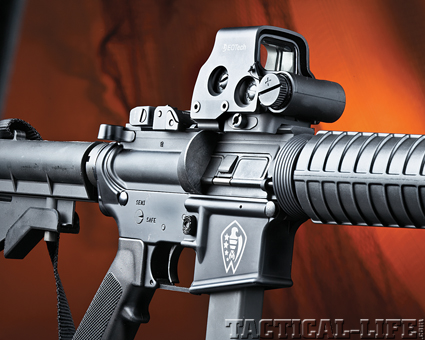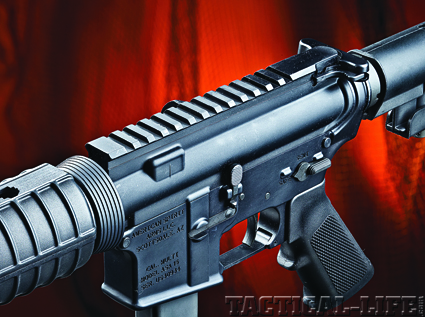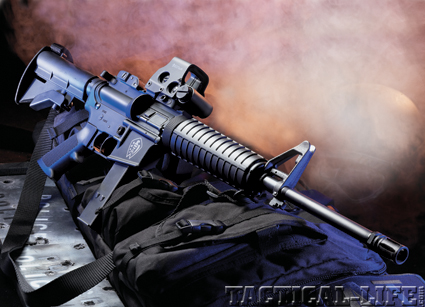Combining the proven handling characteristics of the AR-pattern carbine with a controllable pistol-caliber chambering, the ASA 9mm provides an excellent patrol carbine option for law enforcement officers.
Gun Details
For many departments, the first urge toward a 9mm carbine is a short-barreled rifle (SBR) a la the Heckler & Koch MP5. However, many departments will not want to undergo the paperwork for a SBR—yes, even law enforcement departments have requirements for BATFE compliance even though it is not as stringent as civilian. Fortunately, the 16-inch barreled ASA 9mm still retains the handling characteristics of its short-barreled military predecessor.

Note the lack of a forward assist assembly as well as the unique abbreviated ejection port/dustcover door forward of the large shell deflector.
Advertisement — Continue Reading Below
The ASA 9mm is 36 inches in overall length and weighs slightly over 7 pounds. The collapsible buttstock offers a modicum of compactness, but more importantly ensures a user the proper length of pull no matter gear or equipment being worn. The ASA 9mm benefits from proven M16/AR-15 ergonomics, operating controls, ease of accessorizing, sights, and other modifications that have evolved over the years since the original Colt 635 9mm submachine gun was introduced; not to mention broad familiarity with the M16/AR-15 platform in the shooting culture. The ASA 9mm carbine operates with modified Uzi magazines.

The 9mm carbine sports a flattop, A3-style upper receiver assembly for easy mounting of optics, although a fixed carry handle variant is also offered.
Some will question the utility of employing a pistol cartridge in a shoulder-fired weapon. Most engagements happen well within a 100-yard range in law enforcement or civilian settings, therefore handling and reliability playing more of a factor in quick, reactive engagements rather than specific caliber used. Also, less experienced shooters will find the lower recoil impulse and muzzle blast of a pistol caliber easier to manage, which often times will translate into better accuracy.
Differences between 9mm AR and 5.56mm AR is that the 9mm AR works via blowback operation, while the rifle-chambered AR works via gas impingement. The bolt carrier on the 9mm AR needs to be much heavier due to this operating method. It is one piece as compared to the 5.56mm rotating bolt head. The bolt still recoils into the buffer tube located in the stock; thus side-folding stocks are not an option with the 9mm ARs. The 9mm bolt face is integral to the bolt and the bolt itself is totally different in configuration due to making room for an ejector that protrudes up from the magazine block sliding along its length. Lastly, there are no rotating/locking lugs on the 9mm bolt face.
Advertisement — Continue Reading Below
























